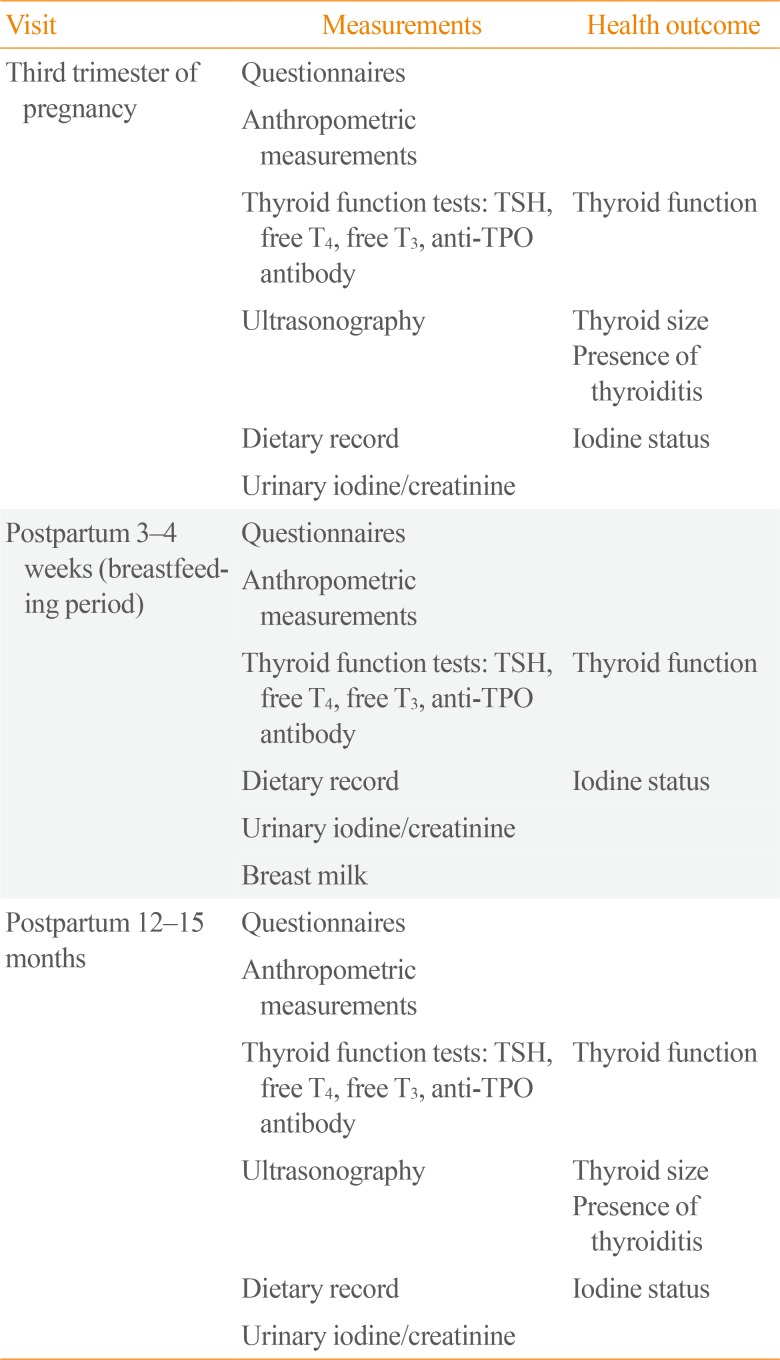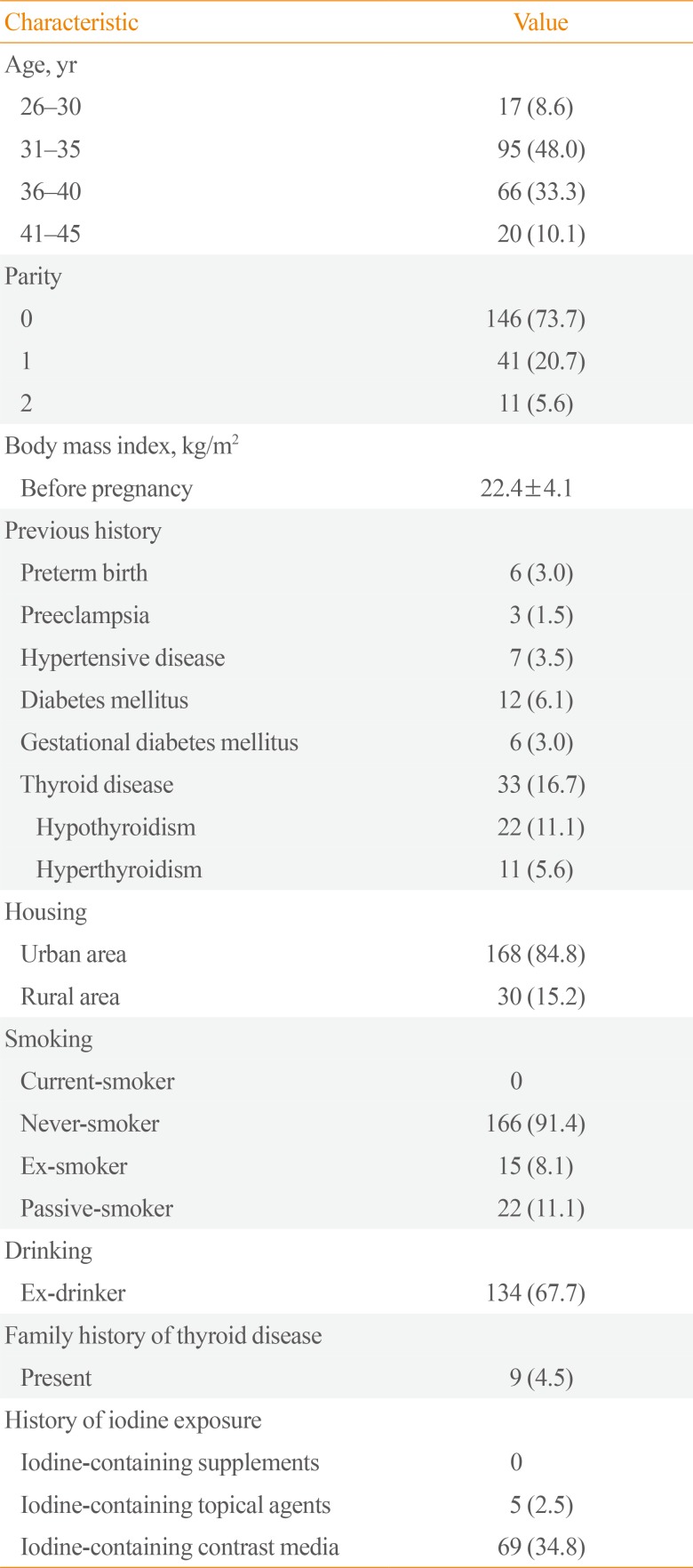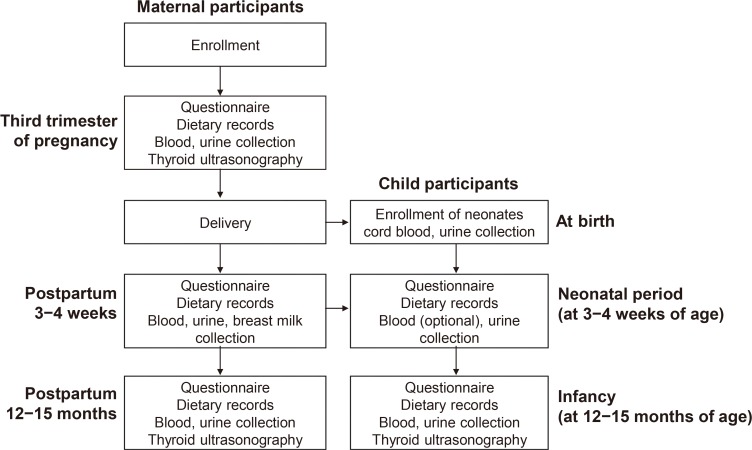1. Zimmermann MB, Andersson M. Update on iodine status worldwide. Curr Opin Endocrinol Diabetes Obes. 2012; 19:382–387. PMID:
22892867.

2. Leung AM, Braverman LE. Consequences of excess iodine. Nat Rev Endocrinol. 2014; 10:136–142. PMID:
24342882.

3. Wolff J, Chaikoff IL, Goldberg RC, Meier JR. The temporary nature of the inhibitory action of excess iodine on organic iodine synthesis in the normal thyroid. Endocrinology. 1949; 45:504–513. PMID:
15396709.
4. Eng PH, Cardona GR, Fang SL, Previti M, Alex S, Carrasco N, et al. Escape from the acute Wolff-Chaikoff effect is associated with a decrease in thyroid sodium/iodide symporter messenger ribonucleic acid and protein. Endocrinology. 1999; 140:3404–3410. PMID:
10433193.
5. Markou K, Georgopoulos N, Kyriazopoulou V, Vagenakis AG. Iodine-induced hypothyroidism. Thyroid. 2001; 11:501–510. PMID:
11396709.

6. Connelly KJ, Boston BA, Pearce EN, Sesser D, Snyder D, Braverman LE, et al. Congenital hypothyroidism caused by excess prenatal maternal iodine ingestion. J Pediatr. 2012; 161:760–762. PMID:
22841183.
7. Shi X, Han C, Li C, Mao J, Wang W, Xie X, et al. Optimal and safe upper limits of iodine intake for early pregnancy in iodine-sufficient regions: a cross-sectional study of 7190 pregnant women in China. J Clin Endocrinol Metab. 2015; 100:1630–1638. PMID:
25629356.

8. Choi YS, Ock S, Kwon S, Jung SB, Seok KH, Kim YJ, et al. Excessive iodine status among school-age children in Korea: a first report. Endocrinol Metab (Seoul). 2017; 32:370–374. PMID:
28956367.

9. Han MR, Ju DL, Park YJ, Paik HY, Song Y. An iodine database for common Korean foods and the association between iodine intake and thyroid disease in Korean adults. Int J Thyroidol. 2015; 8:170–182.

10. Rhee SS, Braverman LE, Pino S, He X, Pearce EN. High iodine content of Korean seaweed soup: a health risk for lactating women and their infants? Thyroid. 2011; 21:927–928. PMID:
21745110.

11. Moon S, Kim J. Iodine content of human milk and dietary iodine intake of Korean lactating mothers. Int J Food Sci Nutr. 1999; 50:165–171. PMID:
10627832.
12. Cho YY, Kim HJ, Oh SY, Choi SJ, Lee SY, Joung JY, et al. Iodine status in healthy pregnant women in Korea: a first report. Eur J Nutr. 2016; 55:469–475. PMID:
25750059.

13. Medici M, Ghassabian A, Visser W, de Muinck, Jaddoe VW, Visser WE, et al. Women with high early pregnancy urinary iodine levels have an increased risk of hyperthyroid newborns: the population-based Generation R Study. Clin Endocrinol (Oxf). 2014; 80:598–606. PMID:
23992400.

14. Yang J, Zhu L, Li X, Zheng H, Wang Z, Hao Z, et al. Maternal iodine status during lactation and infant weight and length in Henan Province, China. BMC Pregnancy Childbirth. 2017; 17:383. PMID:
29145827.

15. World Health Organization. Assessment of iodine deficiency disorders and monitoring their elimination. 3rd ed. Geneva: World Health Organization;2007.
16. Leung AM, Avram AM, Brenner AV, Duntas LH, Ehrenkranz J, Hennessey JV, et al. Potential risks of excess iodine ingestion and exposure: statement by the American Thyroid Association Public Health Committee. Thyroid. 2015; 25:145–146. PMID:
25275241.

17. Pearce EN, Lazarus JH, Moreno-Reyes R, Zimmermann MB. Consequences of iodine deficiency and excess in pregnant women: an overview of current knowns and unknowns. Am J Clin Nutr. 2016; 104(Suppl 3):918S–923S. PMID:
27534632.

18. Chung HR, Shin CH, Yang SW, Choi CW, Kim BI. Subclinical hypothyroidism in Korean preterm infants associated with high levels of iodine in breast milk. J Clin Endocrinol Metab. 2009; 94:4444–4447. PMID:
19808851.

19. Liu L, Wang D, Liu P, Meng F, Wen D, Jia Q, et al. The relationship between iodine nutrition and thyroid disease in lactating women with different iodine intakes. Br J Nutr. 2015; 114:1487–1495. PMID:
26365041.

20. Pal N, Samanta SK, Chakraborty A, Chandra NK, Chandra AK. Interrelationship between iodine nutritional status of lactating mothers and their absolutely breast-fed infants in coastal districts of Gangetic West Bengal in India. Eur J Pediatr. 2018; 177:39–45. PMID:
29063209.
21. Institute of Medicine Food and Nutrition Board. Dietary reference intakes. Washington, DC: National Academies Press;2006.
22. Sang Z, Wei W, Zhao N, Zhang G, Chen W, Liu H, et al. Thyroid dysfunction during late gestation is associated with excessive iodine intake in pregnant women. J Clin Endocrinol Metab. 2012; 97:E1363–E1369. PMID:
22669304.

23. Aakre I, Bjoro T, Norheim I, Strand TA, Barikmo I, Henjum S. Excessive iodine intake and thyroid dysfunction among lactating Saharawi women. J Trace Elem Med Biol. 2015; 31:279–284. PMID:
25447589.

24. Aakre I, Strand TA, Bjoro T, Norheim I, Barikmo I, Ares S, et al. Thyroid function among breastfed children with chronically excessive iodine intakes. Nutrients. 2016; 8:E398. PMID:
27367720.

25. Yang XF, Xu J, Hou XH, Guo HL, Hao LP, Yao P, et al. Developmental toxic effects of chronic exposure to high doses of iodine in the mouse. Reprod Toxicol. 2006; 22:725–730. PMID:
16996244.

26. Nishiyama S, Mikeda T, Okada T, Nakamura K, Kotani T, Hishinuma A. Transient hypothyroidism or persistent hyperthyrotropinemia in neonates born to mothers with excessive iodine intake. Thyroid. 2004; 14:1077–1083. PMID:
15650362.

27. Marco A, Vicente A, Castro E, Eva Perez C, Rodriguez O, Merchan MA, et al. Patterns of iodine intake and urinary iodine concentrations during pregnancy and blood thyroid-stimulating hormone concentrations in the newborn progeny. Thyroid. 2010; 20:1295–1299. PMID:
20950254.

28. Chen W, Sang Z, Tan L, Zhang S, Dong F, Chu Z, et al. Neonatal thyroid function born to mothers living with long-term excessive iodine intake from drinking water. Clin Endocrinol (Oxf). 2015; 83:399–404. PMID:
25280177.








 PDF
PDF ePub
ePub Citation
Citation Print
Print




 XML Download
XML Download